In recent years, educational games have surged in popularity. As a modern fusion of entertainment and learning, they’ve captivated the minds of both children and adults alike. This unique blend of education and gaming has transformed the way we approach learning, revolutionizing traditional teaching methods.
Remarkably, these games engage players at various cognitive levels. Complex problem-solving tasks challenge the mind, while simpler, more straightforward activities provide relief. This fascinating juxtaposition of complexity with bursts of simplicity creates an environment conducive to learning. Educational games thus promote the growth of essential skills, such as critical thinking, creativity, and collaboration.
The appeal of educational games transcends age groups and demographics. Parents appreciate the opportunity for their children to learn while having fun, and educators are increasingly integrating these games into their curriculum. Meanwhile, students willingly immerse themselves in the engaging world of interactive learning.
In this digital age, if you’re also planning to opt for educational game development to launch your game, this article is for you. We will explore everything that you need to know about educational game development and how much it costs. Before that, let’s look at some critical statistics about educational games.
Educational Games Statistics
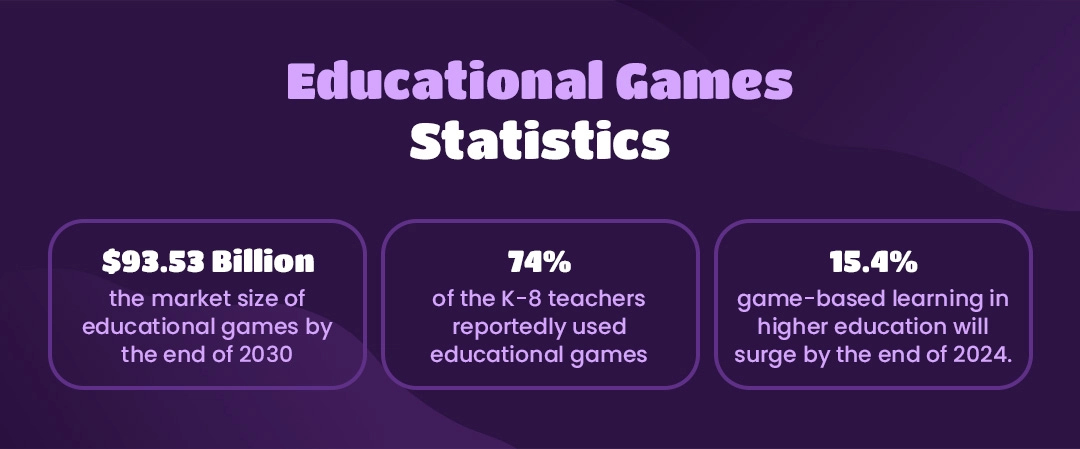
1. According to reports, the market size of educational games was around $11.24 billion in 2021, and it’s expected to touch the mark of $93.53 billion by the end of 2030.
2. Around 74% of the K-8 teachers reportedly used educational games to instruct students for better and more interactive learning.
3. According to reports, game-based learning in higher education will surge by around 15.4% by the end of 2024.
On this note, let’s explore the benefits of opting for educational mobile game development for your audience.
Benefits of Developing an Educational Game
The world of gaming has expanded rapidly, and the advent of educational games has brought a new dimension to learning. In this section, we’ll delve into the numerous benefits of developing an educational game while keeping perplexity and burstiness in mind.
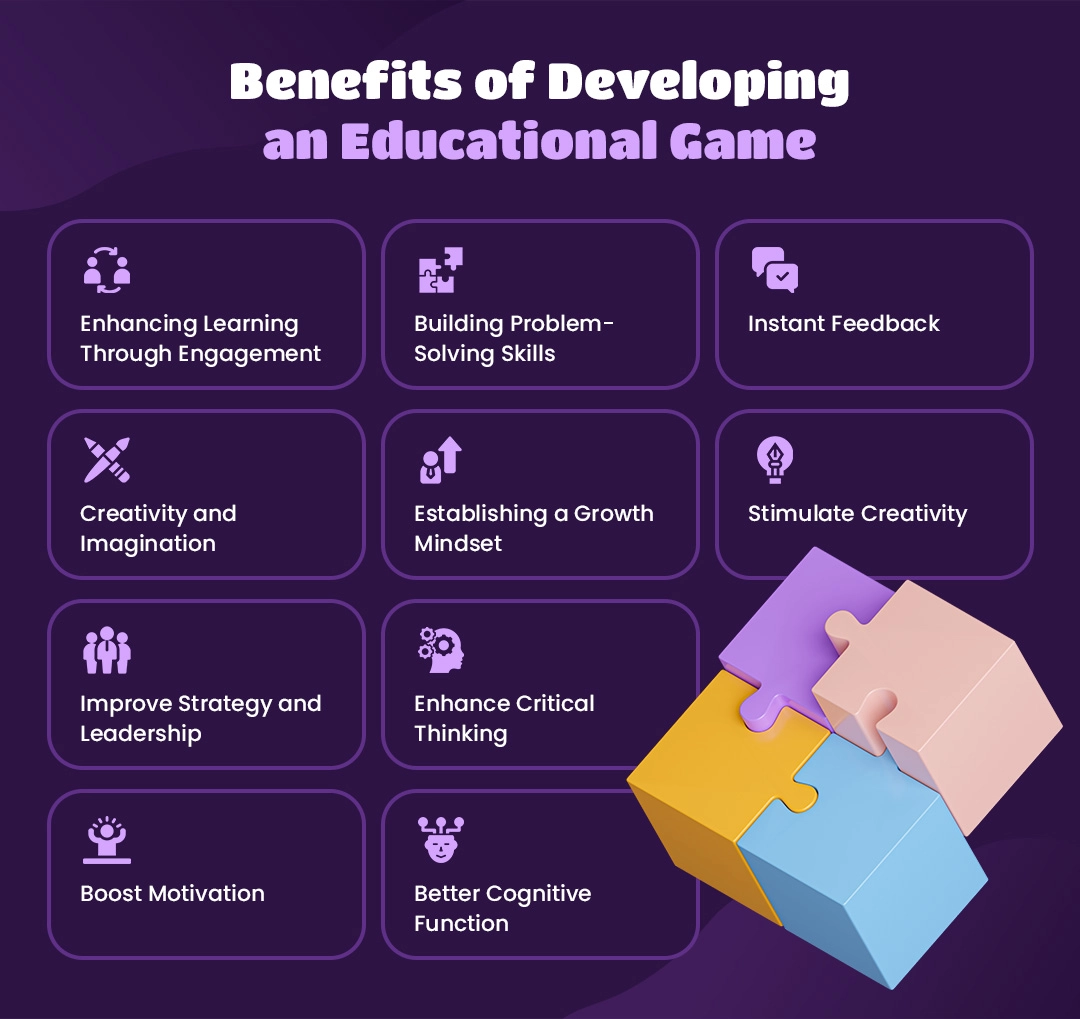
1. Enhancing Learning Through Engagement
With educational game development, you can captivate learners by using interactive elements that make complex concepts easier to grasp. These games provide a fun, engaging experience, increasing students’ motivation to learn. Furthermore, with educational games, you can tailor content to suit individual learners’ needs. This adaptability ensures an inclusive learning environment for students with varying abilities and learning styles.
2. Building Problem-Solving Skills
By incorporating challenges and puzzles, educational games help develop critical thinking and problem-solving skills. Players must analyze situations and strategize to progress through levels or solve in-game problems. Moreover, many educational games incorporate cooperative gameplay, encouraging players to work together toward common goals. This collaboration promotes teamwork, communication, and social skills.
3. Instant Feedback
Games often provide immediate feedback, allowing learners to understand their mistakes, correct them, and improve. Instant feedback is essential for reinforcing positive behaviors and fostering a growth mindset. Along with instant feedback, educational games can simulate real-world situations in a safe, controlled environment. This simulation helps students build practical skills and confidence before applying their knowledge in real-life settings.
4. Creativity and Imagination
Educational mobile game development solutions encourage creativity and imagination, as game designers must create captivating storylines, characters, and environments. These aspects not only enhance the player’s experience but also stimulate their imagination. Furthermore, digital games can be accessed from various devices, making education more accessible to a broader audience. Additionally, educational games can provide cost-effective learning solutions compared to traditional educational materials.
5. Establishing a Growth Mindset
By introducing challenges and obstacles, educational games help develop a growth mindset in learners. Players learn to embrace challenges, persist through setbacks, and view failures as opportunities for growth. Furthermore, educational games often include built-in systems for tracking players’ progress and performance. This data helps educators identify areas where students may need additional support or practice.
6. Stimulate Creativity
When designing an educational game, developers tap into their creative side. They must invent engaging narratives, devise unique game mechanics, and craft distinctive visual elements. Players, too, benefit from the opportunity to think creatively when solving problems and exploring virtual worlds.
7. Improve Strategy and Leadership
Educational games often challenge players to make decisions that impact outcomes. This encourages strategic thinking and fosters leadership skills as players weigh options and consider consequences. In multiplayer games, teamwork and collaboration become essential for success.
8. Enhance Critical Thinking
Games can be designed to incorporate dilemmas, puzzles, or mysteries that require players to assess information and think critically. By presenting complex scenarios, educational games push players to analyze situations, identify patterns, and make logical deductions.
9. Boost Motivation
The interactive nature of educational games keeps players engaged and motivated. With clear goals, achievable milestones, and enticing rewards, games inspire players to persevere, promoting a sense of accomplishment and self-confidence.
10. Better Cognitive Function
Gaming can positively impact cognitive function, and with professional outsourcing game development services, you can help improve cognitive functions. Educational games, in particular, can improve memory, attention, and problem-solving abilities. By exercising the brain in various ways, players sharpen their mental faculties and enhance their cognitive prowess.
After exploring the benefits, let’s explore how to develop an educational game from scratch so that you can have a better understanding.
How to Develop an Educational Game?
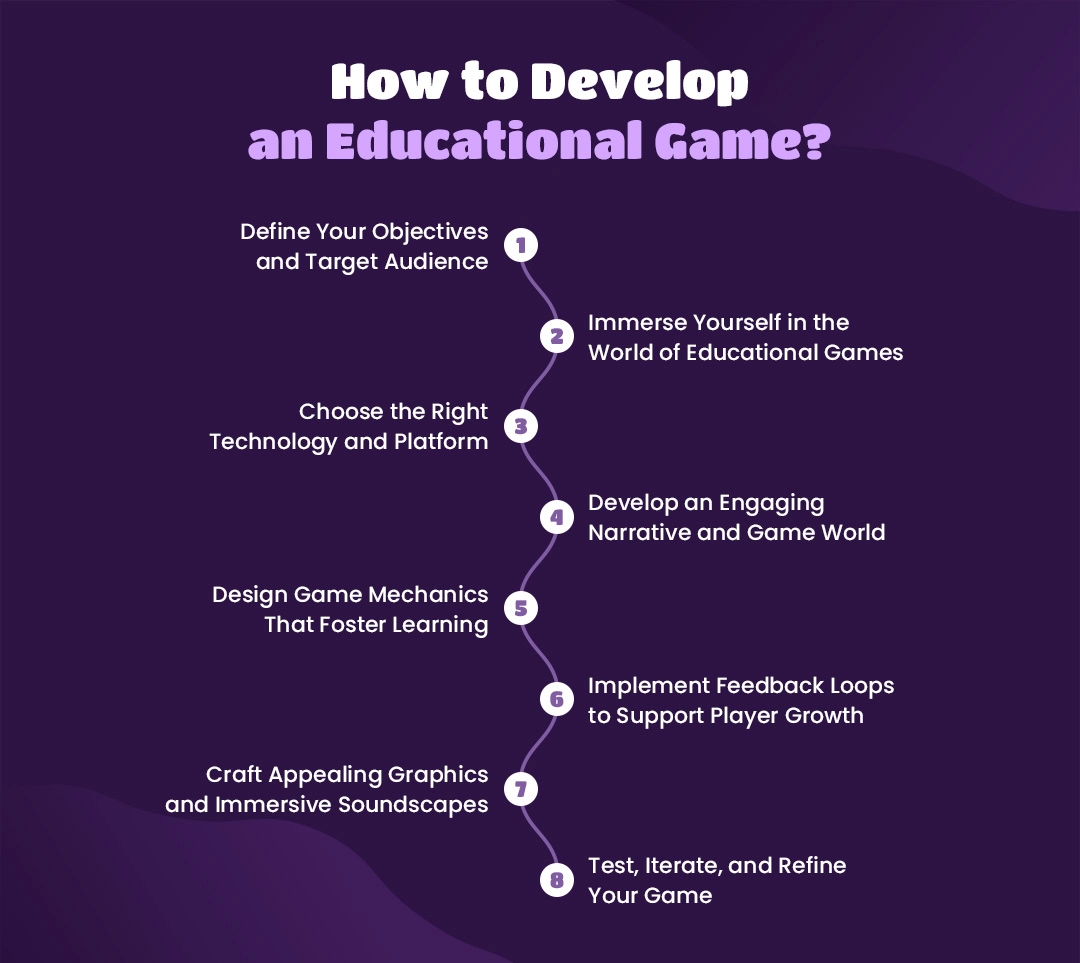
1. Define Your Objectives and Target Audience
Embarking on the journey to create an educational game begins with identifying your goals. What do you hope to achieve? Are you striving to teach a specific subject or skill or want to cultivate a love for learning? Regardless, it’s crucial to outline clear objectives that will anchor your project and guide subsequent decisions.
Equally important is defining your target audience. Consider your potential players’ age group, educational background, and interests. This information will help you tailor the game to their needs and preferences.
2. Immerse Yourself in the World of Educational Games
Before diving headfirst into development, take the time to research existing educational games. Analyze popular titles within your target demographic and identify the elements that contribute to their success. Keep an eye out for patterns and best practices that can inform your design choices.
Additionally, don’t hesitate to consult experts in the field. Educators, psychologists, and fellow game developers can offer valuable insights that can enrich your project.
3. Choose the Right Technology and Platform
The next step is selecting the appropriate technology and platform for your game. This decision will impact its accessibility, cost, and overall development experience. Factors to consider include ease of use, as some game engines are more beginner-friendly than others.
Furthermore, the cost of licensing and subscription models vary between platforms, and you need to do in-depth research on what exactly you need. Moreover, ensure that your chosen technology supports your target devices (e.g., PC, console, mobile). Popular game development platforms include Unity, Unreal Engine, and Godot. Each has its advantages and drawbacks, so weigh your options carefully.

4. Develop an Engaging Narrative and Game World
A compelling narrative can captivate players and provide context for the gameplay. Craft a story that resonates with your target audience while also reinforcing the educational objectives. Consider the game world as well; a richly detailed environment can immerse players and enhance their learning experience.
Remember to keep things varied and engaging when developing your narrative and game world. To maintain player interest, incorporate a mix of simple and more complex story elements, characters, and settings. Hire an experienced educational game development team who has a better understanding of the complete game development process.
5. Design Game Mechanics That Foster Learning
Game mechanics are the foundation upon which your educational game will be built. They determine how players interact with the game world and, ultimately, how they learn. To maximize the learning potential, design mechanics that challenge players to think critically and solve problems, encourage exploration, and promote collaboration and communication among players.
Offer opportunities for creative expression and customization for better user engagement. Also, strive for a balance between simplicity and complexity in your mechanics. This will ensure that your game remains accessible while offering depth and variety in gameplay.
6. Implement Feedback Loops to Support Player Growth
Effective feedback is essential to the learning process. In the context of an educational game, this means providing players with clear and timely information about their performance.
Positive feedback, such as rewards, praise, or progress indicators, helps reinforce successful behaviors. Negative feedback, like penalties or setbacks, signals areas for improvement. Striking a balance between the two is key to maintaining player motivation and promoting growth.
7. Craft Appealing Graphics and Immersive Soundscapes
The audiovisual elements of your gameplay play a significant role in its overall appeal. High-quality graphics can captivate players and immerse them in the gaming world, while a well-designed soundscape can set the mood and complement the game’s theme.
Invest time and resources in developing these aspects of your game. If necessary, consider collaborating with professional artists and sound designers to ensure that your game’s visuals and audio are top-notch. Take the help of a professional game development company to gain an edge and speed up the process.
8. Test, Iterate, and Refine Your Game
Once your educational game is fully developed, it’s time to put it to the test. Gather feedback from diverse playtesters, including educators, students, and casual gamers. This will help you identify areas for improvement and inform subsequent iterations of your game.
Feel free to make substantial changes based on the feedback you receive. The development process is iterative, and refining your game is crucial to its success.

Now, let’s explore how long it will take to design and develop a compelling educational game for your audience.
How Long Does It Take to Build an Educational Game?
Creating an educational game is an exciting task, but the time it takes to build one can vary a lot. The time required to build an educational game depends on many things. The game’s complexity, your team size, and who you’re making it for all play a part in how long it will take to finish.
A simple game teaching young kids basic math might take just a few months with a small team. But, if you want to make a big, detailed game teaching with additional features and functionality, it could take 6 to 8 months. Thus, it’s important to opt for educational game development services from a professional game development company like Auxano Global Services.
After exploring the time estimation, it’s time to understand the factors that affect the cost of developing an educational game.
Factors Affecting the Cost of Creating an Educational Game
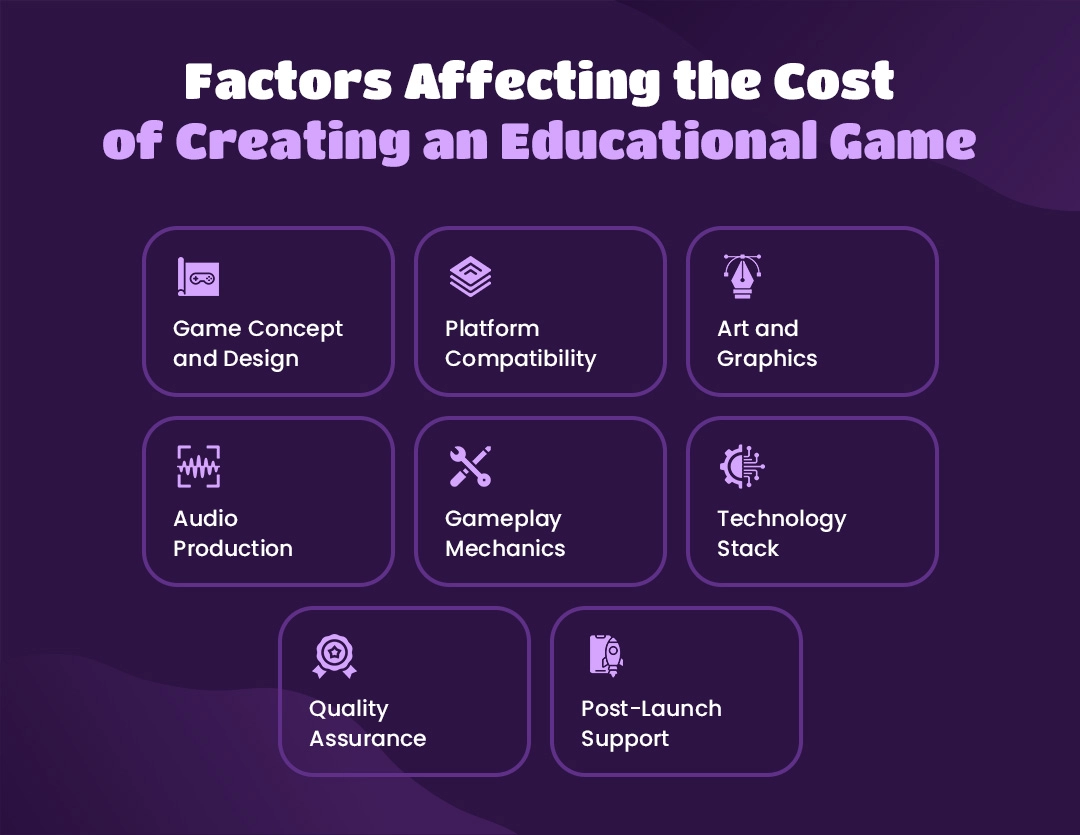
1. Game Concept and Design
A game’s concept and design lay the foundation for its success. The more intricate and detailed your game idea, the higher the costs associated with developing it. Investing time in research, brainstorming, and prototyping is essential for creating a captivating educational experience. Thus, before you hire dedicated game developers, it’s important you have clear concepts and goals in mind.
2. Platform Compatibility
Compatibility with multiple platforms is crucial for reaching a broader audience. Developing a game that works seamlessly across platforms requires additional resources, testing, and expertise, which ultimately affects the budget.
3. Art and Graphics
Visual appeal plays a significant role in engaging players. High-quality art and graphics require skilled designers, illustrators, and animators. The complexity of the visual assets, style, and animations will impact the overall cost of the educational game.
4. Audio Production
Sound effects, music, and voice acting are vital elements that contribute to an immersive gaming experience. Hiring professional composers and voice actors, as well as licensing existing audio, can increase the project’s budget.
5. Gameplay Mechanics
Developing unique gameplay mechanics requires extensive research, testing, and iteration. Complex mechanics, such as physics-based puzzles or branching narratives, demand more time and resources, influencing the final expenses.
6. Technology Stack
The choice of programming languages, game engines, and frameworks affects both development time and cost. Opting for open-source tools may reduce expenses, but proprietary technologies often offer more robust features and support.
7. Quality Assurance
Thorough quality assurance testing is essential for a polished and bug-free game. Depending on the complexity of the game, QA testing can be time-consuming, requiring skilled testers to ensure top-notch performance.
8. Post-Launch Support
Ongoing support, updates, and content expansions can significantly increase the lifespan of your educational game. However, these additional efforts require resources and maintenance, adding to the total expenditure.
On this note, let’s explore how much it will cost to develop a bespoke educational game for your audience.
How Much Does It Cost To Develop an Educational Game?
Developing an educational game can be a rewarding endeavor, but the costs involved can vary considerably based on numerous factors. From the intricacies of game design to the choice of the technology stack, every aspect plays a crucial role in determining the overall expenditure.
It’s essential to strike a balance between your vision and budget constraints, ensuring you create an engaging and effective learning experience without breaking the bank. On average, developing an educational game with MVP features will cost you between $25,000 to $45,000. If you want more features and functionality the cost of developing is up to $45,000 to $75,000 or more. To find out the exact price, feel free to contact our experts.
Now, let’s check out some crucial aspects that will help you optimize and reduce the overall development cost of the educational game. Whether you’re developing a simple game or an intricate one, these tips will help.
Strategies for Reducing Educational Game Development Cost
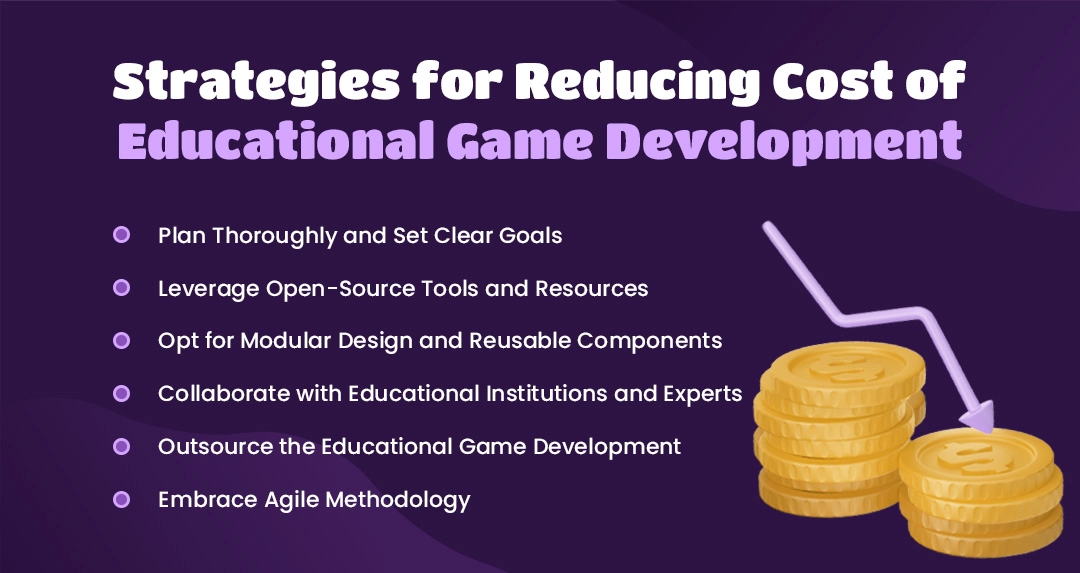
1. Plan Thoroughly and Set Clear Goals
Before embarking on the development journey, it’s crucial to establish a detailed plan outlining your objectives and desired outcomes. By setting clear goals, you will be able to avoid unnecessary expenses and allocate resources efficiently.
Consider brainstorming with your team and discussing various aspects of the project, such as target audience, desired learning outcomes, game mechanics, and overall design. Having a clear vision from the outset will save you from making costly changes later in the development process. With a clear vision, it becomes easier to hire the best educational game developers.
2. Leverage Open-Source Tools and Resources
Utilizing open-source tools and resources can significantly reduce educational game development costs. Many free or low-cost development platforms, game engines, and asset libraries are available, catering to various skill levels and needs.
For instance, Unity and Unreal Engine are powerful game engines that offer extensive features and support for educational game development. Additionally, websites like OpenGameArt.org or FreeSound.org provide royalty-free assets, including graphics, sounds, and music, which can be used in your projects.
By embracing open-source options, you’re not only cutting costs but also contributing to a collaborative community of developers and creators.
3. Opt for Modular Design and Reusable Components
Adopting a modular design approach enables you to create reusable components, streamlining the development process and reducing costs. By designing game elements that can be easily modified, you’ll be able to adapt and reuse them in future projects, saving time and resources.
This strategy is beneficial when developing a series of educational games with similar themes or mechanics. By reusing and repurposing components, you can maintain consistency and coherence across the series while minimizing educational game development costs.
4. Collaborate with Educational Institutions and Experts
Partnering with educational institutions or experts can provide valuable insights and resources, helping you create a more effective and engaging educational game. These collaborations can lead to financial support, access to research materials, or even opportunities for co-development.
Engaging with experts in the field will not only streamline your development process but also ensure that your game is grounded in sound pedagogical principles.
5. Outsource the Educational Game Development
Outsourcing educational game development can be a strategic move for reducing costs while maintaining quality. By partnering with a specialized outsourcing game development company, you gain access to a diverse pool of talent and expertise, allowing for a broader range of ideas and perspectives. Moreover, outsourcing frees up your internal resources, enabling you to focus on other aspects of your project.
It’s essential to carefully select your outsourcing partner, considering factors such as experience, portfolio, and communication style. Establishing a strong working relationship and open communication channels ensures that both parties are aligned in their goals and expectations, ultimately resulting in a successful and cost-effective educational game. It’s important that you hire an experienced educational game development company like Auxano Global Services to ensure a streamlined process.
6. Embrace Agile Methodology
Opting for agile methodology in educational game development can lead to significant cost savings and enhanced efficiency. Agile’s iterative approach allows for quick adaptation to change, fostering creativity and innovation while minimizing the risk of costly mistakes. By embracing this flexible framework, developers can respond to feedback more effectively, ensuring that their games align with user needs and expectations.
Moreover, Agile methodology promotes collaboration and transparency among team members, which can facilitate problem-solving and enhance overall productivity. By breaking down the development process into manageable sprints, teams can focus on delivering high-quality work within tight deadlines. In essence, employing Agile methodology in educational game development can yield impressive results, balancing cost reduction with the creation of engaging and effective learning experiences.
Wrapping up!
In conclusion, the cost of developing an educational game can vary greatly depending on multiple factors, such as design complexity, chosen tools, and development methodology. By incorporating strategic approaches like outsourcing game development, leveraging open-source resources, and adopting Agile methodology, game developers can effectively balance costs with the desired level of quality.
Ultimately, it’s crucial to weigh the potential benefits of these strategies against your specific goals and constraints, ensuring that you create a captivating and instructive educational game without exceeding your budget.
Frequently Asked Questions
-
1. What are the critical elements of a successful educational game?
Key elements include clear learning objectives, intuitive game mechanics, captivating visuals, and an adaptive difficulty level that challenges players while maintaining their interest.
-
2. How can I ensure that my educational game appeals to my target audience?
To create a game that resonates with your target audience, it’s crucial to conduct thorough research on their preferences, interests, and learning needs. Engage with potential players through surveys, interviews, or focus groups to gather insights that inform your game design.
-
3. What are some popular game engines for educational game development?
Unity and Unreal Engine are two widely-used game engines that offer extensive features, support, and community resources for educational game development.
-
4. How can I measure the effectiveness of my educational game?
Collect data on user performance, such as completion rates, assessment scores, and in-game progress, to assess learning outcomes. Simultaneously, track player behavior and feedback to gauge overall engagement and satisfaction.
-
5. How much does it cost to create an educational game?
Development costs for an educational game with MVP features are between $25,000 to $45,000. In order to add more features and functionality, you’ll have to spend $45,000 to $75,000 or more. If you want to know the exact price feel free to contact our professionals now.



![Cost to Develop Coding Learning App like WhiteHat Jr [2021]](https://www.auxanoglobalservices.com/agsresources/wp-content/uploads/2021/08/Cost-to-Develop-Coding-Learning-App-like-WhiteHat-Jr-AGS.jpg)
![Outsource Game Development [Complete Guide 2023]](https://www.auxanoglobalservices.com/agsresources/wp-content/uploads/2023/06/Outsource-Game-Development-Complete-Guide-2023.jpg)
